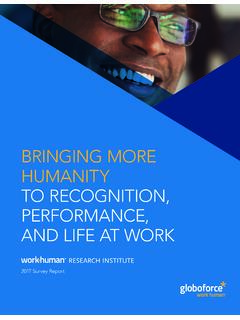Transcription of The Recognition Issue - kciphilanthropy.com
1 As 2012 draws to a close, we here at KCI find ourselves reflecting on the year that was. So many things happenedover the past twelve months The LondonOlympics, Superstorm Sandy and the to name but a the Philanthropic Trends Quarterlyedito-rial team, 2012 was also the Year of theDonor . Admittedly, this focus was some-what accidental as we didn t set out withthat theme in mind. Yet, every topic weexplored seemed to weave its way back toone central theme donors and what theywant and expect from us. So to cap off theYear of the Donor, we turn our attention inthis edition of Philanthropic Trends Quarterlyto donor you may be thinking - What newcould possibly be said about Recognition ? Well, as we ve discovered through ourresearch and conversations with thoughtleaders throughout North America, a the most fascinating thing for meis that Recognition , like so many elements of philanthropy and fundraising, is under-going a rethink to ensure that it continuesto meet its objectives in this increasinglysophisticated and competitive of my personal aha moments camefrom something shared with me by one of my KCI colleagues.
2 For the past severalyears, her 11 year old son has donated hisbirthday money to an animal welfareorganization. He makes these gifts in hon-our of his cherished pet cat, which wasadopted from the charity. Donating thismoney is really important to him - soimportant, in fact, that he chooses to makehis gift in person. He recently received aletter from the organization asking if hewould consider making another to be receiving mail addressed tohim personally from his special charity, heexcitedly opened the letter. But upon read-ing it, his excitement turned to hadn t acknowledged his previousgifts. And you know what he asked They don t know who I am.
3 Don t theyremember me? The innocence of his reaction, one that isnot coloured by adult understanding ofthings that might have led to the oversight,made me think that we need to go back tothe root of the word Recognition , which is to recognize . By not acknowledging hisprevious gifts, my colleague s son didn t feel recognized .I worry that our preoccupation with donorwalls, annual reports and naming opportu-nities, which make up the lion s share ofconversations about Recognition , has led usto lose sight of the intent of Recognition ,which is to make our donors feel appreciat-ed and special, and perhaps most impor-tantly, part of our families . And so, I encourage you to allow the conceptof we know who you are and what youhave done for our organization be yourguide when thinking about what s importantwhen it comes to recognizing your donors.
4 Best wishes for the upcoming holiday here s to a great 2013!Marnie A. SpearsPresident and CEO2012: Issue 4 The Recognition IssueWINTER 20122 Donor walls. Naming report to most any development profes-sional about donor Recognition andthese are the things that will likelycome up. Traditionally thought of as a best practicemust do item to be completed at the end of a campaign, thinking and conver-sations about donor Recognition havetended to reside solely in the realm of thetactical. But many leading fundraisers arearguing that s not enough anymore, say-ing that donor Recognition is no longer (ifit ever should have been) about checkingoff a box on a checklist. Arguing that thisapproach, with its sense of finality, missesthe opportunities that Recognition offersto charities for developing deep and longlasting relationships with donors.
5 Rather,they say that we should be adopting a long term, ongoing mindset when itcomes to Recognition , using it as one of anumber of tools to build better relation-ships with our donors and bring themcloser to so, there is a sense that the time isright to reimagine and redefine recogni-tion, acknowledging that limiting the dis-cussion to tactics takes too narrow a viewin Canada s ever evolving and maturingphilanthropic vs. Private recognitionOne of the ways Recognition is beingrethought is by nuancing its definition todistinguish between public and thinking of Recognition , the ten-dency is to focus solely on the public sideof the definition - the ways that we pub-licly acknowledge our donors and thegifts they make to us.
6 Of course, not alldonors want to be recognized publicly,preferring to keep their gifts , it s safe to say that all donors want,and in fact expect, private Recognition to be assured that they are known to and appreciated by the charities that they support. Think about the donors in your ownorganization, particularly loyal donorswho have given to you for 10, 20 or even40 years. When you send a letter to themdo you let them know that you recog-nize them? And we mean really recognizethem. Not in a thank you for your previ-ous donations kind of way. But in a Mary,we know that you have given to ourorganization for the past 20 years. Yourgenerosity has been noticed and is soappreciated.
7 Thank you. kind of way. The two acknowledgements have a veryBeyond the donor wall: rethinking recognitionWINTER 20123different feeling and tone, with the lattermaking the donor feel like they are trulyknown to the organization. And it does-n t have to be hard. Do some analysis andsegmentation of your database and you llbe well on your way to being able to rec-ognize your long term donors in this this mindset means that recog-nition comes in many forms, and almostany interaction with the donor is anopportunity to recognize them. Quietand personal moments like when theyreceive a letter, no matter the intent, andit thanks them in a very personal way fortheir gift. Or when they order a ticket fora show or exhibit and the order taker isprompted by the system that they arespeaking to a donor.
8 A powerful tool inbuilding relationships with donors, pri-vate Recognition is something that hasnot been given enough time and atten-tion in the vast majority of than just the moneyNo conversation about donor recogni-tion would be complete without talkingto donors. And what they say aboutrecognition just might surprise Jan Belanger, Assistant Vice PresidentCommunity Affairs at Great-West Life, Lon-don Life, and Canada Life, the best recog-nition goes well beyond acknowledgingthe monetary value of their gift. The mostmeaningful Recognition we receive cele-brates the relationship between us andthe charity that we are supporting, whichalways goes beyond a financial contribu-tion, says Belanger. For example, we tendto be early donors to many projects, andthis early support often helps to bringother contributions to the table.
9 Some ofthe most meaningful and effective recog-nition that we ve experienced recognizesthis aspect of our support..all donors want, and infact expect, private recog-nition to be assured thatthey are known to andappreciated by the charitiesthat they support. Rethinking donor relationsIt s impossible to talk about donorrecognition without exploring thebroader concept of donor relations, thespot where Recognition most oftenresides in both our thinking as well asour organizational in the same way that donor recog-nition is currently experiencing a peri-od of reimagining, so too is donor rela-tions undergoing a metamorphosis inboth thinking and approach. The objectives of Donor RelationsPrograms are self-evident and relativelyunchanging building long lastingrelationships, making donors feel likepart of the family and showing donorsthe impact of their gifts.
10 What is differ-ent is the approach that is being takento achieve those objectives. The old model of donor relations tendsto be activity based at its core, with thekey pillars being Recognition and stew-ardship activities. In defining the waywe interact with our donors in theweeks, months and maybe (or maybenot) years following their gifts, thesetwo terms guide both our philosophyas well as our tactics. Organizing ourthinking in this way has kept our focusperhaps more narrow than it should new model is centred around thedonor and takes a broader view of theways and means available to organiza-tions to achieve the objective of build-ing deep and long lasting relationshipswith donors. It realizes that donor rela-tions is animated by much more thanjust Recognition and stewardship activ-ities, while at the same time realizingthat there are elements of recognitionand stewardship in all ReportImpact StatementsPersonalized letters/reportsStewardship OpportunityDonor WallDonor model of donor relations -ACTIVITY CENTREDNew model of donor relations -DONOR CENTREDMISSIONENGAGEMENTREPORTING & ACCOUNTABILITYPRIVATE RECOGNITIONGENERAL COMMUNICATIONSPUBLIC RECOGNITIOND onor relationsWINTER 20124 Belanger points to Goodwill Industriesserving Southwestern Ontario as anexample of an organization that man-aged to do just that when recognizingtheir support for a capital renewal proj-ect.








